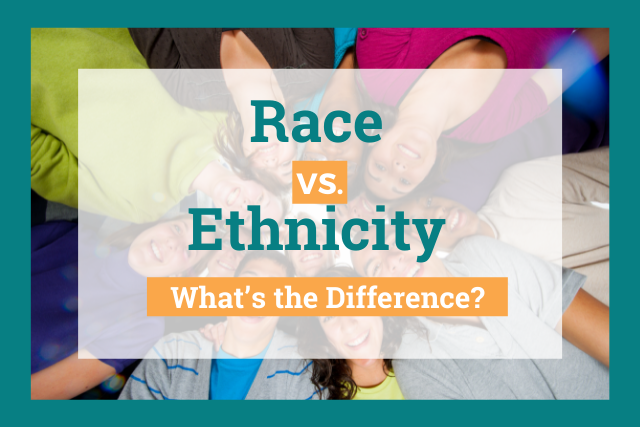
Race and ethnicity are two concepts that often overlap, but there are subtle and important differences. Both terms denote social categorization of human beings and, because of the incredibly complex history of these subjects, carry a lot of baggage and varied meanings to different people.
At its most fundamental, it breaks down to this:
Race denotes a population of people who often share some similar physical characteristics and who often trace their ancestry back to the same general regions of the world (however, people travel and can have similar traits while sharing no ancestry, so this is not always the case).
One could also argue that the very idea of race is grandfathered in from erroneous 19th-century ideas about racial hierarchy. Regardless, the word is still used widely today, so it’s important to understand what it means to most people.
Meanwhile, ethnicity is a bit clearer to understand: it’s about your culture of origin—and can refer to the culture of your ancestors, even if you’re not directly part of that tradition.
Language, music, art, food—these are just some of the characteristics that reflect one’s ethnicity. There may be shared physical traits as well, due to the overlap that’s often present between linked ethnic and racial groups, but that part is (often) race.
So, ethnicity probably tells you more about what a person might be like because it denotes behavior. Race, however, is pretty much just skin-deep, and describes some of the physical traits a certain population might share.
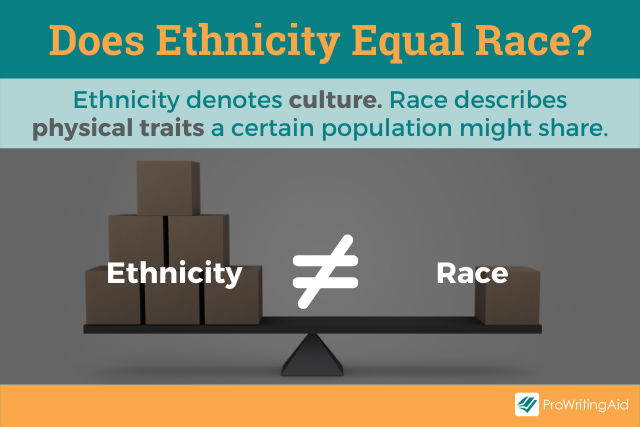
- How Is Race Determined?
- Race Focuses on Broad Physical Characteristics
- Is Race Based on Genetics?
- Ethnicity Focuses on Cultural Characteristics
- How Many Ethnic Groups Exist?
- Why Are Race and Ethnicity Such Complicated Concepts?
- Using Terms Related to Race and Ethnicity
- What’s the Difference Between Race vs. Ethnicity?
How Is Race Determined?
Cambridge dictionary provides two definitions of race. Take careful note of the subtle, yet meaningful, difference.
one of the main groups to which people are often considered to belong, based on physical characteristics that they are perceived to share such as skin color, eye shape, etc.
the idea that people can be divided into different groups based on physical characteristics that they are perceived to share such as skin color, eye shape, etc. or the dividing of people in this way.
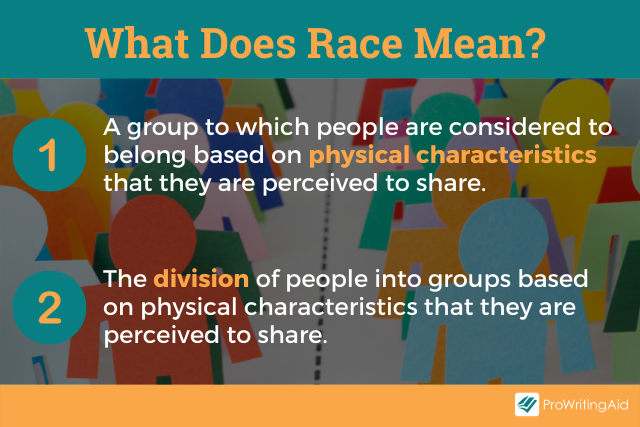
The first definition probably confirms what you already knew or assumed: a person’s race refers to distinctive physical characteristics such as skin color, eye shape, and hair color/texture. It can also include the ancestry or experiences people have shared based on or because of those physical traits.
That second definition emphasizes that race is not just physical, but philosophical.
Both definitions are essential for understanding what race is and the role it plays in society.
Race Focuses on Broad Physical Characteristics
You have likely filled out a form or application at some point that has asked you to check the box to identify your race. The U.S. Census list includes these racial categories:
- American Indian or Alaska Native
- Asian
- Black or African American
- Native Hawaiian or Pacific Islander
- White
- Two or more races
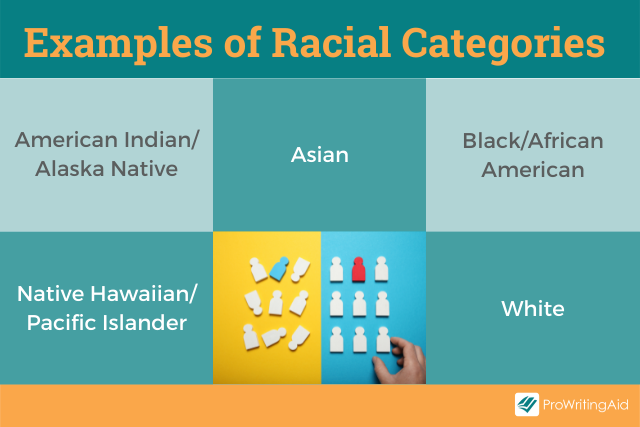
As you can see, these categories are extremely broad. For example, Asian could refer to someone whose ancestry is Chinese (East Asian) or Indian (South Asian), and while people from those respective areas are both classified as Asian, in general, they will have different physical characteristics.
Most of us have more nuanced perceptions of race than the Census. However, our perception and the census categories share a commonality: neither informs us of the essence or aspects of a person’s identity other than what their physical appearance reveals.
That’s not to say one’s racial identity is unimportant. For many, that identity is a source of pride and an important element of who they are.
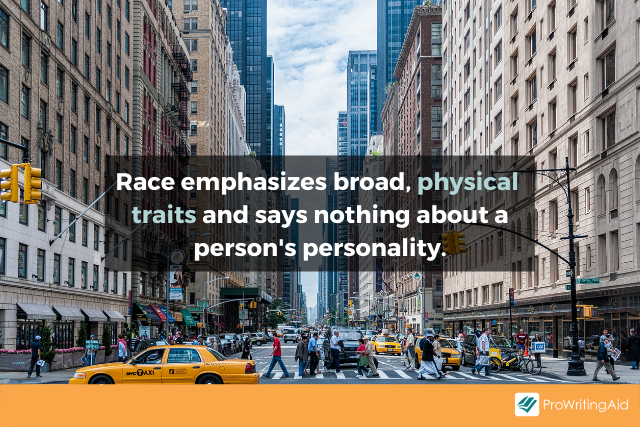
Racial identity is powerful. It has been and still is used to create a sense of shared history and community, and sadly, it has been and still is used as a way to divide people.
Is Race Based on Genetics?
No.
While race does refer to broad, distinctive physical traits, physical traits do not equate to genetic makeup.
Past thinking was that people of one race had significant biological differences from people of other races. That thinking prompted the oppression of one race by another throughout history, seen most obviously in slavery. The race in power saw themselves as superior and other races as inferior.
While science has shown that understanding to be wrong, we still see the long-term effects of its damage in continued racial prejudice and discrimination.
Research indicates there is no evidence that races have genetic identities specific to themselves alone.
In her article, “Do Races Differ? Not Really, Genes Show” Natalie Angier reports that scientists say:
while it may seem easy to tell at a glance whether a person is Caucasian, African or Asian, the ease dissolves when one probes beneath surface characteristics and scans the genome for DNA hallmarks of “race.”
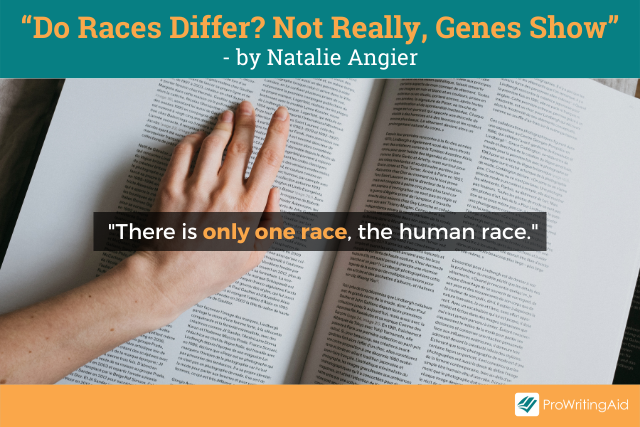
Further, significant genetic variations exist within people of shared races. A fascinating study of the full genomes of two scientists of European ancestry and one of Korean ancestry revealed that each of the European scientists was more genetically similar to the Korean scientist than to each other.
Genome researcher Dr. J. Craig Ventor, one of the scientists of European ancestry included in the aforementioned study, along with other researchers, says the physical traits we use to differentiate races from each other are controlled by a small number of genes and as a result, have been able to change in response to environmental forces during the “short course of Homo Sapiens history.”
What we might identify as "racial groups" are essentially socially constructed groups based on method of categorization that doesn’t go deeper than the surface of the skin.
Ethnicity Focuses on Cultural Characteristics
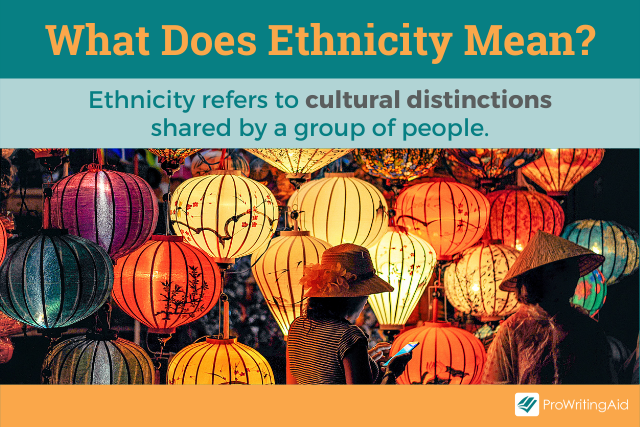
Ethnicity refers to cultural distinctions shared by a group of people. An ethnicity is therefore a group with common cultural values, religious beliefs, history, or nationality—or any combination of those areas.
Ethnicity involves matters of identity that go deeper than the surface of the skin.
Ethnicity provides room for the nuances of human identity that race categories cannot fully address. For example, two people may share a racial category of Black, but feel their identities are better expressed through their ethnicities, such as Haitian or Jamaican or Italian, depending on their country and/or cultural origin or those they share affiliations with.
People of different races can have a shared ethnicity. For example, a person can be Black and ethnically Italian, or White and ethnically Italian. A person can be racially White and ethnically Irish or racially White and ethnically Spanish. A person can be categorized as Asian racially and identify ethnically as Christian or be racially Asian and ethnically Muslim.
Ethnic categories are much more specific than racial categories and can be broken down further based on a person’s religion, sect within a religion, or dialect, to name a few subcategories.
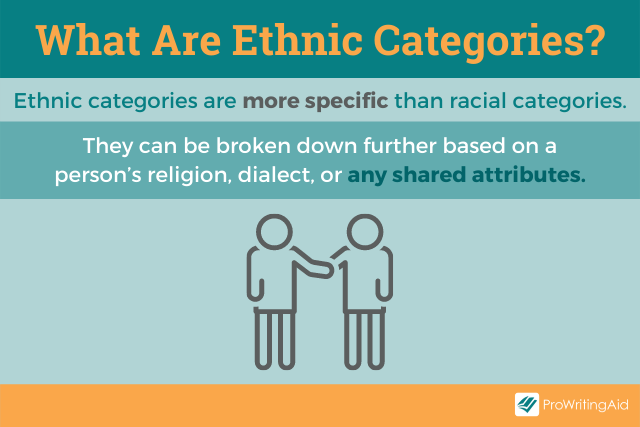
How Many Ethnic Groups Exist?
There are hundreds and possibly thousands of ethnic categories. Somewhat strangely, the U.S. Census lists only two: Hispanic or Latino or Not Hispanic or Latino. Perhaps the list of ethnicities would just be too long?
These categories also raise this question for some: why aren’t Hispanic and Latino listed as races? For some answers and some insight into the history and social impact of race and ethnicity, check out Gene Demby’s article.
Why Are Race and Ethnicity Such Complicated Concepts?
For one thing, matters of identity are deeply personal and individual. That’s one reason using these terms can seem complicated. People are complex, and trying to put ourselves or others into cookie-cutter categories doesn’t work so well.
Additionally, while race and ethnicity are distinct terms, we sometimes use or apply them interchangeably, whether with good intentions, because the people around us do, or just out of ignorance. We might use a person’s apparent race to make assumptions about their ethnicity—their cultural affiliations, religious beliefs, food preferences, values, etc.
Even though race and ethnicity refer to different aspects of a person’s identity, they are often related. It makes sense that people from the same place may share ethnic markers and racial features. It’s important to remember, though, that this isn’t always the case and we shouldn’t make assumptions or generalize.
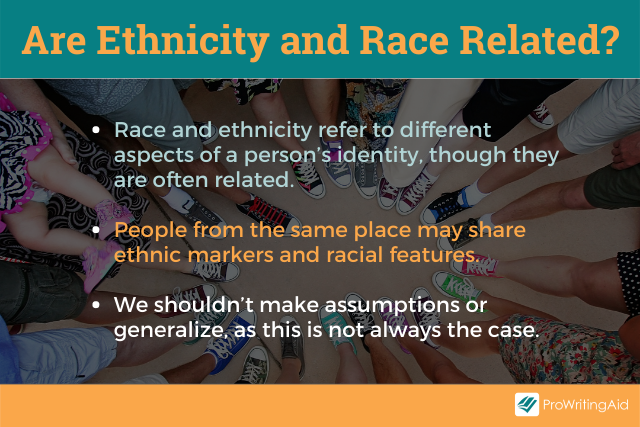
Throughout history up to and including today’s world, race and ethnicity have also been used as grounds for discriminatory and oppressive behavior. Sometimes, we are uncomfortable examining those behaviors and/or for holding ourselves or others accountable.
Another reason for complication: language is fluid. Definitions and word connotations change over time; we can feel intimidated and worry that we’ll say the wrong thing.
I’m sure I have not covered all the reasons for the complexity of these concepts; even so, you might be feeling overwhelmed.
But don’t give up. Remember all the degree programs related to studies of race and ethnicity? Their existence means there are plenty of experts and resources you can learn from and use to stay current on this important topic.
In the meantime, there are some things you should remember when it comes to communicating about race and ethnicity.
Using Terms Related to Race and Ethnicity
You should only include a person or group’s racial or ethnic identity if it’s relevant and/or wanted. For example, if you are celebrating someone as the first “enter identity here” CEO of the company, and the new CEO wants that identity included, then it’s relevant.
If that identity is extraneous, leave it out. For example, there’s no reason to tell a supervisor, “I’m having a problem with my colleague, the (enter identity here) one.” This holds for positive comments as well. There’s no need to say “I enjoy working with my (enter identity here) colleague.”
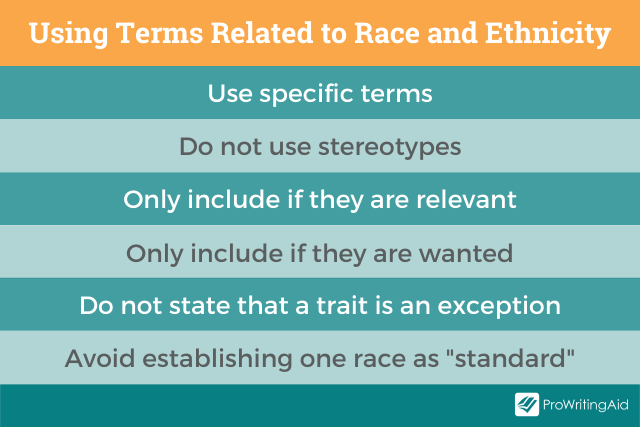
In general, it’s better to use specific rather than broad terms when describing identities. For example, you would say Korean American rather than Asian American, or Italian American rather than European American. The specificity acknowledges that there is nuance among races and ethnicities—not everyone from one continent or region is the same.
Avoid making comparisons that establish one race as the “standard.” For example, saying “Compared to White students, non-White students...” could imply, depending on the purpose of your comparison, that you perceive “White” as the dominant, centered race, and the one to which all others are compared.
If the context and purpose of your comparison make it necessary to compare the experiences of one race as compared to others, perhaps to see if there are discriminatory practices occurring, then that language would be appropriate.
Do not stereotype. Not even if you think you’re being complimentary. Do not make comments such as “(enter identity here) are the best _ _ _ _ _ _.” Stereotypes are not compliments.
Do not use qualifiers to indicate that a characteristic is an exception to a particular race or ethnicity. For example, even if you think statements such as “these _ _ _ _ _ _ workers are extremely competent” or “they are such insightful _ _ _ _ _ _ students” are complimentary, they aren’t. You’re actually implying that the positive trait you’re praising the person or group for is not typical among “this” group.
If you’re referencing ethnic groups in your writing, you’ll want to ensure that they are spelt correctly. ProWritingAid’s Style Guide allows you to personalize your own report rules specific to your rules. Input the names you want and it will flag any deviations it picks up.
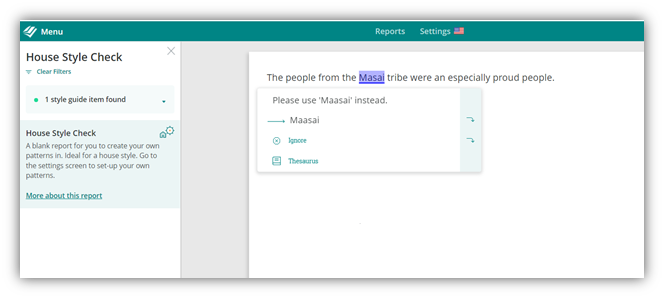
Try Style Guides with a free ProWritingAid account.
What’s the Difference Between Race vs. Ethnicity?
Here are some key takeaways to remember about race and ethnicity:
- Race and ethnicity can be related, but they are not the same thing.
- Race, for the most part, is based on a person’s general physical characteristics.
- Race is not genetic but is a socially constructed system of categorization.
- Ethnicity refers to the cultural markers or affiliations a person holds.
- People can have different races, but be part of the same ethnic groups (or group).
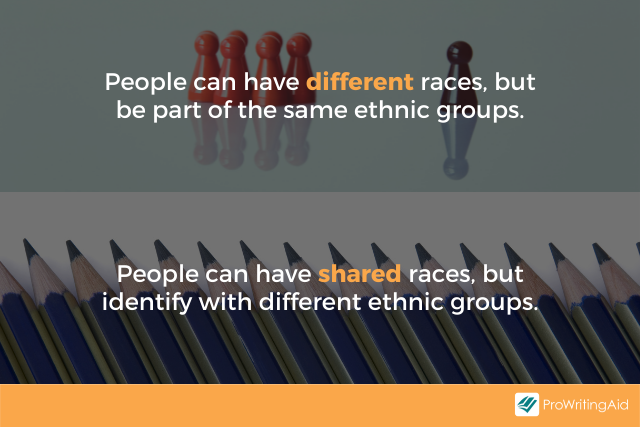
- People can have shared races, but identify with different ethnic groups.
- It’s important to stay current in your understanding of the concepts of race and ethnicity.
- When discussing matters of race and ethnicity, be humble, considerate, and ready to listen and learn. Always.


